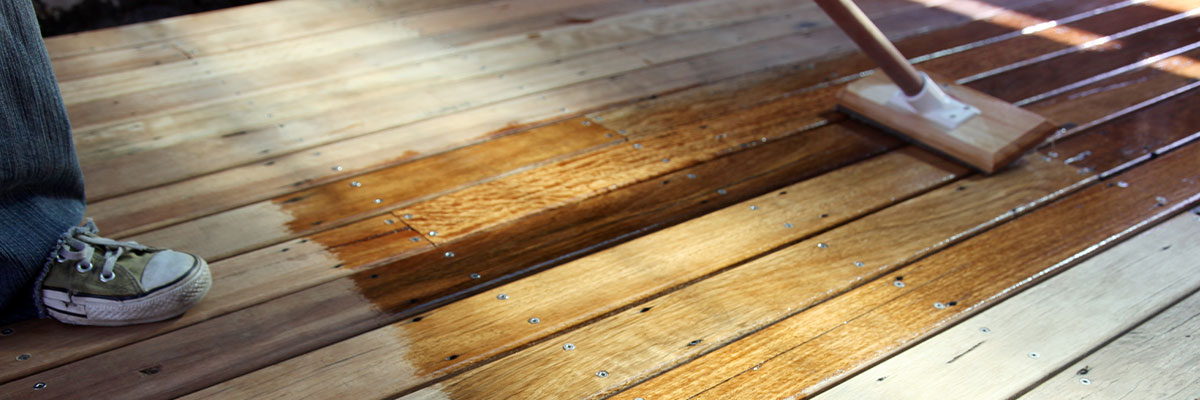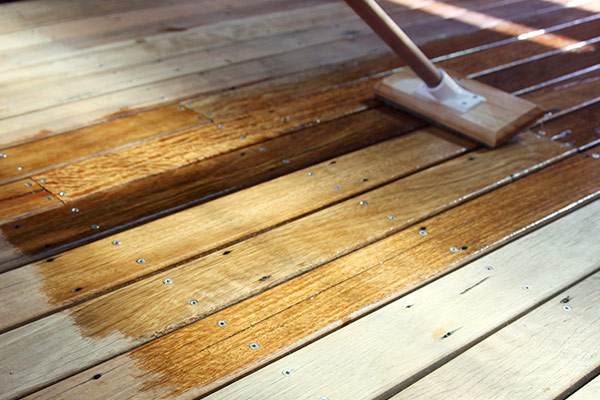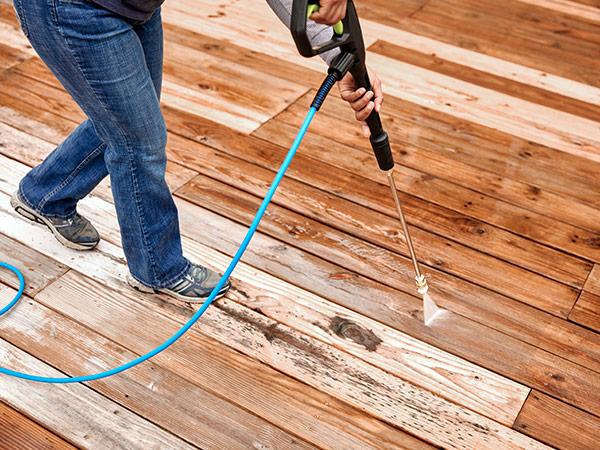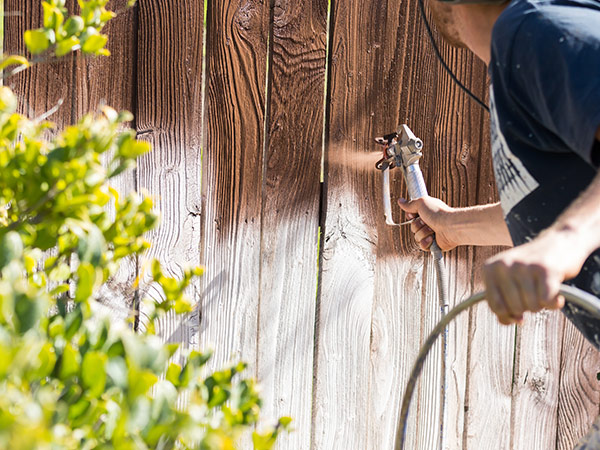

Your Guide to Exterior Wood Stain
Exterior wood stain is a great option to spruce up a shabby backyard deck or help weatherproof your fence. Not only will staining your exterior wood surfaces make them look nice, but most products will also protect the wood against the elements. Even a big job like a fence can be easier that you think with the right tools. Before you start staining, make sure you have what you need to make your deck, fence, or even siding look great and stay protected.
Your Project
The first order of business is to determine if your surface needs to be sealed with a sealer or stain. Do the splash test to see if your wood absorbs water or repels it by pouring a cup of water on the wood. If the water is absorbed, it is time for new stain. Another important consideration is if you have a composite deck. Composite decks are made with different materials and require special care, so be sure to check with the manufacturer to determine if you can stain your deck. However, pressure treated wood will do just fine with a sealant if the surface is dry. A new wood deck or fence will need to wait around three months or more depending on the wood to be stained until it has cured.
Types of Exterior Wood Stains
Many exterior wood stains are also sealants to protect the wood which is why it is important to choose exterior wood stain and not ones rated for interior use. However, if your main goal is to seal and protect against the elements like UV rays and downpours, be sure to read the label before application. Also, note that stain is also different than paint. A main benefit of stain is that it allows the natural grain of the wood to show, while paint is usually opaque and hides the grain completely.
There are four stain options from which to choose based on the look you are trying to achieve.
- Clear wood stain provides protection without any change to the color of the wood.
- Transparent wood stain adds slightly more color and hides some dings.
- Semi-transparent stain adds quite a bit of color and hides some cracks, but still shows the wood grain through.
- Solid stain hides imperfections and can completely change the color of the wood. A solid stain is still thinner than paint and allows the grain to show through after it dries.
There are also different bases for stain and which one you chose could be better for your specific application or wood type. Exterior stain has water- or oil-based options plus a hybrid option. Water-based stain has easier clean up but may not work well on some woods like softwood. Oil-based stains generally need spirit solvents for clean-up but works well on both hardwoods and softwoods and soaks into the wood. Hybrid-bases have the best of both worlds with easy cleanup and will soak deep into the wood.

Prep and Clean

After you have determined if your deck, fence, or even siding needs to be refreshed, it is time to prep and clean. Before you stain anything, make sure the surface is clean so the stain can adhere properly. Do you have any old stain peeling off? Has it been a while since you power-washed? Clean off your deck, fence, or siding with an appropriate cleaner made for decks and other exterior wood surfaces. Or, consider a good power washing if you can do so without damaging the surface.
Some cleaners can be easily applied with a sprayer and a deck scrub brush comes in handy for a little extra elbow grease. There are special cleaners to help you remove old stains. If you are using a chemical stripper to remove old stain, you might need a special cleaner to help neutralize the caustic chemicals first which can prevent the new stain from adhering. Cover any plants with a drop cloth so they aren’t hurt by the chemicals of the cleaner or sealant later.
Let your wood dry before moving on to the next step. Most stains and sealers will only work on a dry surface, so check the weather for a few sunny days with low humidity in the forecast. Check your packaging for instructions before cleaning.
After washing and cleaning, your wood may need some sanding to return it back to its original smooth texture and to prevent splinters. This can be done with an orbital sander, a pole sander, or a sanding sponge for railings. Use a lower grit sandpaper of 60 or 80 grit. Be sure to sweep away all sawdust from sanding before staining.
Finally, fix any boards that may have come loose with a new nail or completely replace if they are warped.

Applying Exterior Wood Stains
Stain and sealer can be applied with a brush, roller, or paint pad and some can even be applied with a paint sprayer. Before you slap the stain all over your surface, try the color out in a low-profile place first to decide if you like it. If you are staining a deck, use painter’s tape around the bottom of your house walls that meet the deck, so stain doesn’t accidentally splatter. Check your product's instructions to see if a second coat of stain is recommended.

6 Quick Tips
- Don’t stain yourself into a corner. Work your way with your stain to an exit so you’re not forced to walk over a fresh coat.
- Remove any decorative hardware.
- Start with any railings before moving on to your deck.
- Keep everything off your newly stained wood surface for at least 24 hours.
- Apply stain in long, even coats to avoid lap marks.
- If applying with a sprayer, it is best to wear a dust mask and eye protection. Avoid very windy days.
![]()
![]() Oily rags are a fire hazard as some chemicals in sealers can spontaneously combust if disposed of improperly. Contact your local waste management company or department for proper disposal information.
Oily rags are a fire hazard as some chemicals in sealers can spontaneously combust if disposed of improperly. Contact your local waste management company or department for proper disposal information.
How to Keep Your Project Looking Nice
After all your hard work in making your project look nice, you want to keep it that way as long as possible. Proper maintenance is key. Frequently sweep off any dead leaves that may have fallen on your deck, make any wood or hardware repairs promptly, and clean off any mold and mildew as soon as you see it. Not only will this help keep your deck, fence, or siding keep their curb appeal, but it will help to keep its value. But don’t stop here, most stains and sealers need to be reapplied every two years or so.
McCoy's Sets You Up for Success
McCoy's has all you need to stain your deck, fence, or siding and keep it looking great for years to come. Want more outdoor DIY to enhance curb appeal? Check out our outdoor DIY ideas or even our outdoor product selection with thousands of products for a back or front yard oasis. Easily buy online and get back outside.

